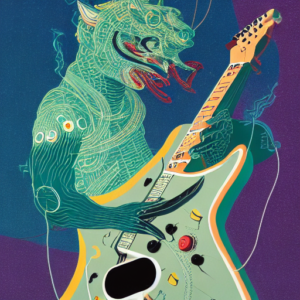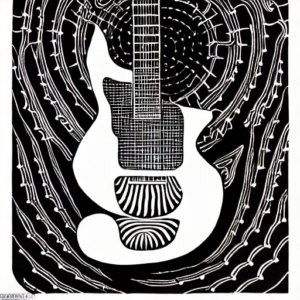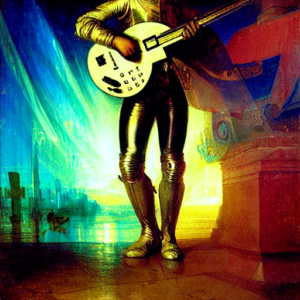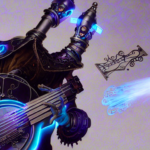Guitar Tapping Technique: An Introduction

Ahoy, fellow Shred enthusiast! If you’re looking to add some pizazz to your playing, I’ve got just the thing for you: guitar tapping technique. From EVH to modern Shred masters, guitar tapping technique has cemented itself as a staple of the Shred style. It can be used to play fast and fluid legato runs, create numerous different types of speed effects in your playing and even expand the range of shred runs and sweep arpeggios.
Now, I’ll be the first to admit that this technique can be a bit of a challenge to master. But with a little bit of practice and some helpful tips from yours truly, you’ll be tapping out intricate melodies in no time. So let’s get started!

What is guitar tapping technique?
First off, let’s define exactly what we mean by “tapping.” Guitar tapping technique is where you use your fretting hand to tap out notes on the neck of the guitar, rather than plucking the strings with a pick or your fingers. In other words, you’re using your fretting hand to basically hammer-on notes on the strings.
It’s a popular technique in rock and metal music, and it’s another form of legato technique but one that allows you to extend the range of anything you’re playing and even play at faster speeds than you could without it. It can also add energy and excitement to your playing.
Tapping is a powerful tool in the arsenal of any self-respecting shredder, and with a bit of practice and dedication, you too can unleash some lightning fast and buttery smooth licks on your unsuspecting audience.
Where do I start?
First things first – get your tapping hand in shape. Guitar tapping technique requires precise finger control and quick reflexes, so it’s important to spend some time building up your hand muscles and coordination.
The best way to get started is to work on some basic exercises designed purely for the first finger (pointer finger) on your tapping hand (the hand you normally use for picking), while using only open strings. Since you’ve already developed your finger muscles and coordination for fretting with your fretting hand, you can start by putting all your attention on your tapping hand before putting them together. Trust me, this is the way to get started.
And don’t forget to work with a metronome!
Auto Amazon Links: No products found. http_request_failed: A valid URL was not provided. URL: https://ws-na.amazon-adsystem.com/widgets/q?SearchIndex=All&multipageStart=0&multipageCount=20&Operation=GetResults&Keywords=B01IP8C04M&InstanceId=0&TemplateId=MobileSearchResults&ServiceVersion=20070822&MarketPlace=US Cache: AAL_ee938cf2b0906d05feb3aaa0215f7f35
Tapping exercise #1
This practice pattern simply alternates between tapping fret 12 of the 1st string and pulling off to the open 1st string. Focus on getting clean notes and playing in time by starting very slowly and practicing with a metronome. You’ll use the first finger on your tapping hand to tap the 12th fret. Also, don’t forget that your fretting hand is doing nothing in this practice pattern.

Tapping exercise #2
For the 2nd practice pattern, you’ll see that you’re working with the same idea as the first, only now you’ll be switching strings from the 1st string to the 2nd string, 3rd string and back again. As with all of these practice patterns, use only the first finger of your tapping hand for every tapped note and work slowly with a metronome until it becomes easy for you. Then you can start to gradually increase the speed.

Tapping exercise #3
For practice pattern 3, you’re back to playing only on the 1st string but now you are going to change what fret your first finger is tapping each time. Use the duration of the open string ringing out after pulling off to change the position of your tapping hand to prepare yourself for tapping the next fret. While this will seem pretty difficult at first, if you take it slow enough with the metronome, it will be a breeze!

Combining the Tapping Hand and Fretting Hand

Once you’ve got the basics down, it’s time to start incorporating tapping into your playing. Start by learning some simple tapping licks and working your way up to more complex patterns. It’s important to start slow and gradually build up your speed and accuracy – otherwise, you risk turning into a gibbering mess of tangled fingers.
Beginner tapping exercises from Matt Zerkovich

As you progress, don’t be afraid to experiment with different tapping techniques and styles. Whether you’re a fan of Eddie Van Halen’s frenetic tapping runs or Joe Satriani’s smooth legato style, there’s a tapping technique out there for every guitarist.
So there you have it, fellow shredders – the essential exercises and techniques for mastering the guitar tapping technique. Now go forth and tap your way to glory!
Shred on!












 in a single picking motion. This allows you to play fast arpeggios and complex chords with ease and fluidity, giving your solos a smooth, cascading sound.
in a single picking motion. This allows you to play fast arpeggios and complex chords with ease and fluidity, giving your solos a smooth, cascading sound. Once you’ve mastered the basics of sweep picking, it’s time to start incorporating it into your playing. Start with simple, two-string arpeggios and work your way up to more complex chords and patterns. As you practice, pay attention to your picking hand and make sure that you’re using a smooth, fluid motion.
Once you’ve mastered the basics of sweep picking, it’s time to start incorporating it into your playing. Start with simple, two-string arpeggios and work your way up to more complex chords and patterns. As you practice, pay attention to your picking hand and make sure that you’re using a smooth, fluid motion.